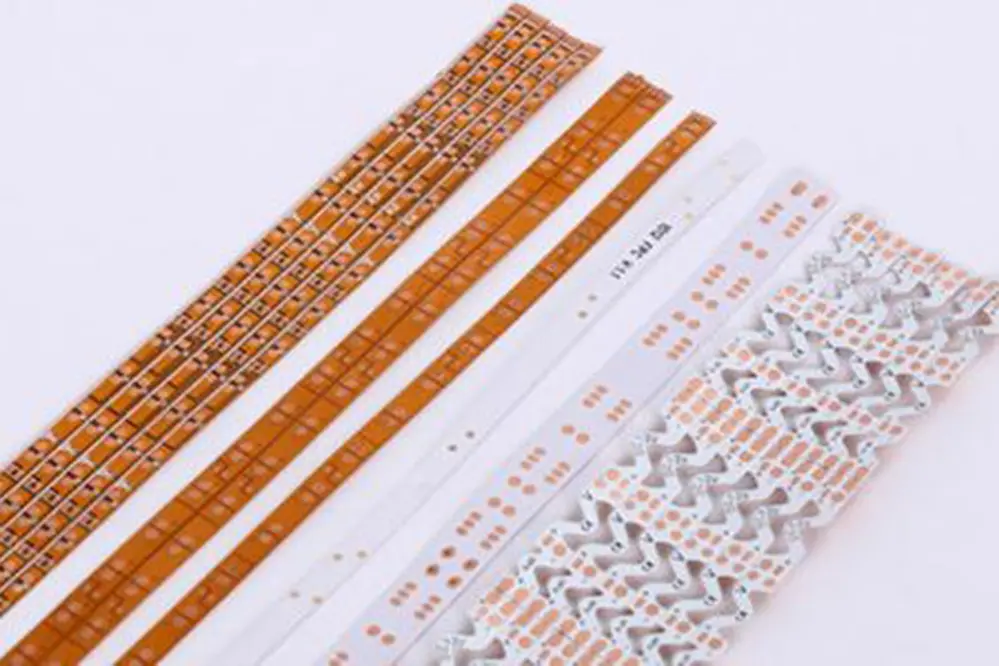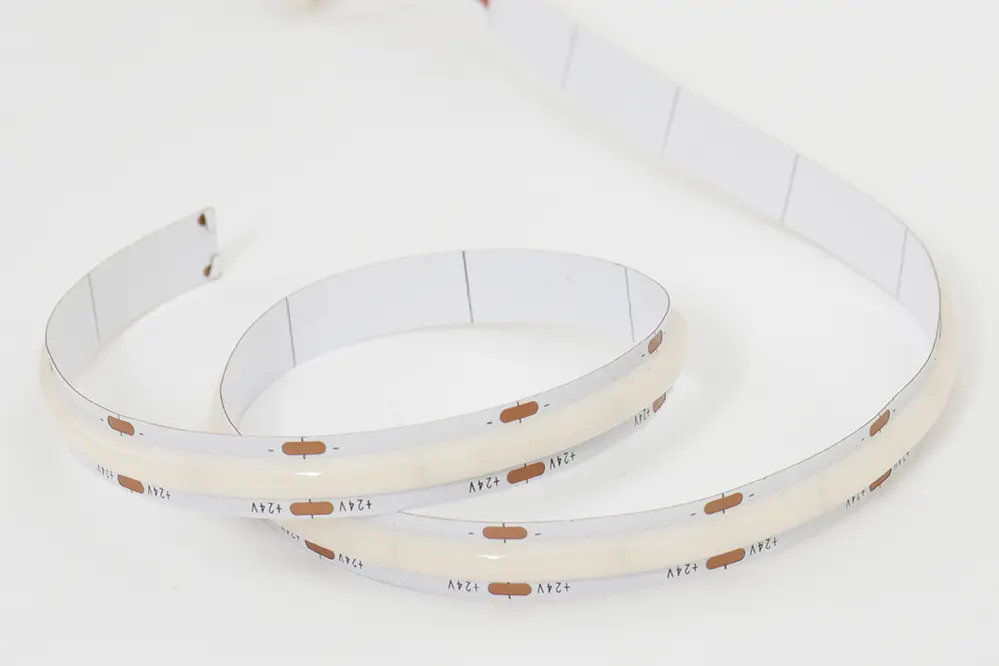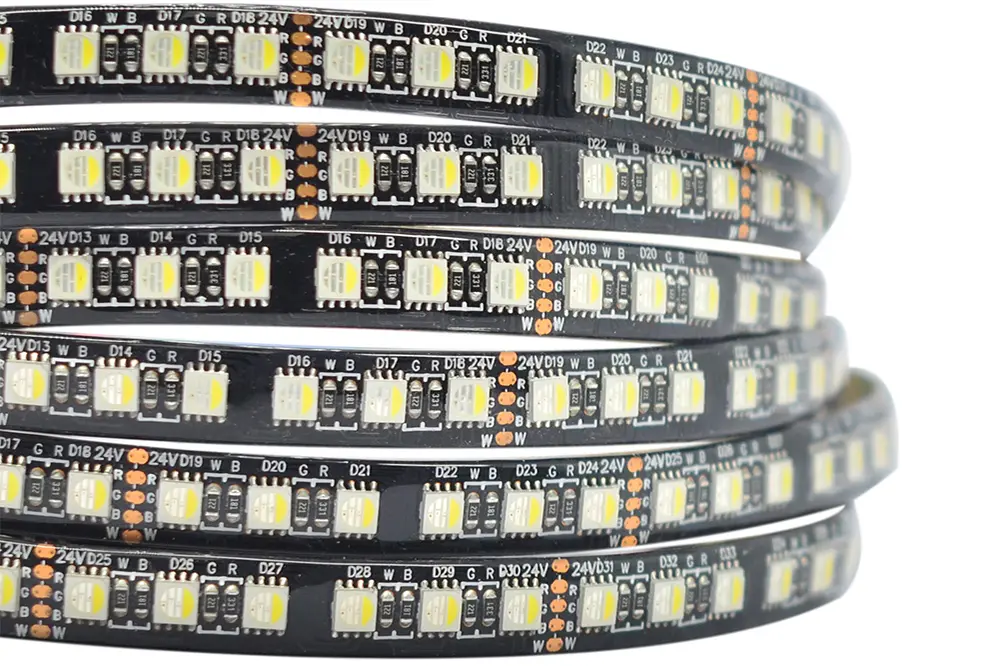LED strips have revolutionized the way we illuminate our spaces, offering flexibility, energy efficiency, and a myriad of design possibilities. One critical but often overlooked aspect of LED strips is the color of the PCB (Printed Circuit Board). This component plays a vital role in the performance, aesthetic, and installation of LED strips. In this blog post, we will explore the differences between white and black PCBs in LED strips, discussing their respective pros and cons to help you make an informed decision.
Understanding PCB in LED Strips

Definition and Function of PCB
A Printed Circuit Board (PCB) is the backbone of any electronic device, including LED strips. It mechanically supports and electrically connects the electronic components using conductive pathways, tracks, or signal traces etched from copper sheets laminated onto a non-conductive substrate. In LED strips, the PCB’s primary function is to provide a stable platform for the LEDs, ensuring proper electrical connections and heat dissipation.
Role of PCB in LED Strip Performance
The PCB’s material, design, and color significantly influence the performance of LED strips. A well-designed PCB ensures efficient electrical conductivity, effective heat management, and durability, which are crucial for maintaining the LEDs’ brightness and longevity. The color of the PCB also impacts the light reflection and overall aesthetic of the LED strip.
White PCB in LED Strips

Overview of White PCB
White PCBs are widely used in LED strips due to their excellent light-reflective properties. The white color helps in reflecting more light, enhancing the brightness and uniformity of the LED strip. This makes white PCBs a popular choice for applications where maximum light output is desired.
Advantages of White PCB
Better Light Reflection
White PCBs are known for their superior light reflection. The white surface reflects more light compared to darker surfaces, resulting in a brighter and more uniform light output. This is particularly beneficial in applications such as display cases, task lighting, or general illumination where high brightness is essential.
Aesthetic Appeal in Certain Settings
In environments with light-colored surfaces, white PCBs blend seamlessly, making the LED strip less noticeable when not in use. This aesthetic integration is crucial in residential and commercial settings where maintaining design harmony is important. The white PCB can complement the surrounding décor, ensuring that the lighting element does not stand out unnecessarily.
Disadvantages of White PCB
Potential Visibility in Installations
In installations where the LED strip is exposed or partially visible, the white PCB can be more noticeable than a black PCB. This can be a drawback in designs where the LED strip needs to be as discreet as possible, such as in modern interiors or entertainment setups where minimal visual disruption is desired.
Cost Considerations
White PCBs can sometimes be more expensive than their black counterparts due to the additional manufacturing processes required to achieve the white finish. Although the cost difference is usually minimal, it can add up in large-scale installations or projects with tight budgets, making it a factor to consider.
Black PCB in LED Strips

Overview of Black PCB
Black PCBs are chosen for their ability to blend into darker environments and for their sleek, unobtrusive appearance. They are often used in settings where the lighting elements need to be discreet or where the visual aesthetics of the installation are a priority.
Advantages of Black PCB
Stealthy Appearance in Installations
The primary advantage of black PCBs is their ability to remain inconspicuous in installations. In settings like home theaters, gaming setups, or in architectural designs with dark color schemes, black PCBs help the LED strips blend into the background, reducing visual clutter. This is particularly useful in environments where the focus should be on the ambiance created by the lighting rather than the lighting fixtures themselves.
Less Visible in Dark Environments
Black PCBs are particularly effective in environments with low lighting or dark surfaces. They minimize reflection and glare, making them ideal for accent lighting in areas where subtlety is key. This makes black PCBs a popular choice for mood lighting, display lighting, and in automotive applications where maintaining a low profile is important.
Disadvantages of Black PCB
Reduced Light Reflection
A significant drawback of black PCBs is their lower light reflection compared to white PCBs. The darker surface absorbs more light, which can affect the overall brightness of the LED strip. This reduced light output may be a concern in applications where maximum brightness is required, such as in retail displays or workspaces where adequate lighting is essential for functionality.
Potential Heat Absorption Issues
Black PCBs can absorb more heat than white PCBs, which can impact the thermal management of the LED strip. Effective heat dissipation is crucial for maintaining the longevity and performance of LEDs. While modern black PCBs are designed to mitigate this issue through advanced materials and designs, it remains a factor to consider, especially in high-power LED strips where heat buildup can be significant.
Comparing White vs Black PCB
Performance and Efficiency
When comparing white and black PCBs, performance and efficiency are key considerations. White PCBs typically offer better light reflection, resulting in higher brightness and more uniform light distribution. Black PCBs, on the other hand, are favored for their discreet appearance and are less visible in dark environments. The choice between the two often depends on the specific requirements of the installation and the desired visual impact.
| Feature | White PCB | Black PCB |
| Light Reflection | High | Low |
| Aesthetic Integration | Blends with light surfaces | Blends with dark surfaces |
| Heat Management | Better (less heat absorption) | Adequate but can absorb more heat |
| Brightness | Higher | Slightly lower |
Performance Comparison
Aesthetic and Design Considerations
The choice between white and black PCB often comes down to aesthetic and design considerations. White PCBs are ideal for installations where brightness and visibility are important, while black PCBs are preferred for their ability to remain unobtrusive in dark environments. The visual impact of the LED strip can be significantly influenced by the color of the PCB, making it an important factor in design decisions.
Cost and Availability
Cost can also play a role in the decision-making process. While the price difference between white and black PCBs is usually minimal, it can be a factor in large projects. Availability is generally not an issue, as both white and black PCBs are widely used and readily available from manufacturers. However, it’s always a good idea to check with suppliers to ensure that the desired PCB color is in stock and can be delivered within the required timeframe.
Choosing the Right PCB for Your LED Strips
Factors to Consider
When choosing between white and black PCB for your LED strips, consider the following factors:
• Installation Environment: Assess the lighting conditions and the color scheme of the installation area. If the environment has light-colored surfaces and requires high brightness, white PCB may be the better choice. Conversely, if the setting is darker and requires a discreet lighting element, black PCB might be more suitable.
• Desired Aesthetic: Determine whether you need the LED strip to be discreet or if brightness is the primary concern. White PCBs can enhance light output and visibility, while black PCBs can blend seamlessly into dark environments.
• Budget Constraints: Evaluate the cost differences and consider your budget. Although the price difference is usually minimal, it can add up in large-scale installations. Make sure to factor in the overall project cost when making your decision.
Expert Recommendations
Best Use Cases for White PCB
White PCBs are best suited for applications where maximum brightness and light uniformity are critical. They are ideal for general illumination, task lighting, and any setting where the LED strip will be visible against a light-colored background. White PCBs can enhance the overall brightness and visibility, making them perfect for retail displays, kitchens, workspaces, and commercial lighting installations.
Best Use Cases for Black PCB
Black PCBs are recommended for installations where the LED strip needs to be discreet. They are perfect for accent lighting, mood lighting, and environments with dark color schemes. Black PCBs are also a great choice for automotive lighting, entertainment setups, and architectural designs where minimal visual disruption is desired. They can blend seamlessly into dark environments, creating a sleek and unobtrusive look.
Additional Considerations
Durability and Longevity
When selecting between white and black PCBs, it’s also important to consider the durability and longevity of the PCB material. High-quality PCBs, regardless of color, should be made from robust materials that can withstand environmental stressors such as humidity, temperature fluctuations, and mechanical wear. Ensure that the PCB you choose has a good track record for reliability and durability.
Installation Ease
Another factor to consider is the ease of installation. Some PCBs may come with additional features such as pre-applied adhesive backing or mounting holes, which can simplify the installation process. Evaluate these features to ensure that the LED strips can be installed efficiently and securely, regardless of the PCB color.
Compatibility with LED Drivers and Controllers
Compatibility with LED drivers and controllers is crucial for optimal performance. Ensure that the PCB color does not interfere with the functionality of the LED drivers or controllers. This is especially important in complex lighting installations where precise control over brightness, color temperature, and dynamic effects is required.
FAQs
Can I mix white and black PCB LED strips in one installation?
Yes, you can mix white and black PCB LED strips in one installation. However, it’s important to consider the overall aesthetic and lighting uniformity. Mixing PCBs may create a visually inconsistent look, so plan your design accordingly.
Are there any significant performance differences between white and black PCB LED strips?
The main performance difference is in light reflection and brightness. White PCBs tend to offer higher brightness due to better light reflection, while black PCBs may have a slightly lower light output. Additionally, black PCBs might absorb more heat, which can impact thermal management.
Which PCB color is more durable?
Durability is generally similar for both white and black PCBs, as it primarily depends on the quality of the materials used and the manufacturing process rather than the color itself. High-quality PCBs, regardless of color, should be made from robust materials that can withstand environmental stressors.
Is there a significant cost difference between white and black PCB LED strips?
The cost difference is usually minimal, but white PCBs can sometimes be slightly more expensive due to the additional manufacturing processes required to achieve the white finish. It’s always best to check with suppliers for the most accurate pricing.
Do white PCBs improve light quality?
White PCBs can enhance light quality by reflecting more light, which helps in achieving higher brightness and uniformity. This can be particularly beneficial in applications where maximum light output and consistent illumination are desired.
Conclusion
Choosing between white and black PCB in LED strips depends on your specific needs and preferences. White PCBs offer better light reflection and are ideal for high-brightness applications, while black PCBs provide a sleek, unobtrusive appearance perfect for discreet installations. By understanding the pros and cons of each, you can make an informed decision that enhances both the functionality and aesthetic of your lighting design.
Whether you’re lighting up a retail space, creating a cozy ambiance in your home, or designing a cutting-edge entertainment setup, the right PCB color can make all the difference. Consider your specific needs, installation environment, and budget to choose the PCB that best suits your project.
For those looking for high-quality LED strip lights and LED neon strips, consider reaching out to Unitop, a professional Chinese manufacturer with extensive experience in the industry. Unitop offers a wide range of innovative and reliable LED lighting solutions tailored to meet various needs and preferences. Their expertise and commitment to quality ensure that you get the best products and support for your lighting projects. Contact Unitop today to explore their offerings and take your lighting design to the next level.





